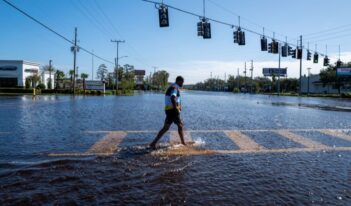
Experts ask if super-storms require new approaches to risk regulation, insurance, and disaster management.
Following Hurricane Sandy, over $75 billion in disaster relief was provided to aid the recovery process. But there are challenges in getting individuals to take steps to reduce losses prior to a disaster, and affordability issues threaten to delay the implementation of key features of the National Flood Insurance Reform Act of 2012.
With these challenges on their minds, a group of policymakers and insurers recently convened at the University of Pennsylvania to discuss whether the risks of flooding from super-storms require new approaches to risk regulation, insurance, and disaster management.
The panel, assembled at the Wharton School and co-sponsored by the Penn Program on Regulation and the Wharton Risk Management Center, used experiences with post-Sandy responses to inform a discussion of the National Flood Insurance Program (NFIP) and the important pre-Sandy reforms adopted in the Biggert-Waters Flood Insurance Reform Act of 2012. Biggert-Waters was actually passed three months before Sandy struck the east coast, but its goal of reducing the growing deficit in the NFIP meant that it took on new significance after Sandy drastically increased the pressure for payment on claims.
Speaking to a standing-room-only audience, the panel addressed a number of important questions on risk mitigation strategies ahead of flooding disasters, the behavioral and equitable impacts of risk-rated premiums under Biggert-Waters, and the ways that federal, state, and local governments and communities are interacting to rebuild from Sandy and prepare for future events.
The panel addressed the sometimes drastic spikes in premiums that homeowners face as their property is reclassified into a high-risk flood plain. These premium spikes might cause premiums to rise significantly and prompt some to leave the floodplain. These effects s are precisely what Biggert-Waters sought to achieve, to at least some degree, in an effort to make NFIP solvent and to deal with the long-term threat of rising sea levels. But critics have argued that the reforms push too far and too fast.

Questions discussed about flood risks.
Roy E. Wright, Deputy Associate Administrator for Mitigation at the Federal Emergency Management Agency (FEMA), began by recounting the history of the NFIP, how it was developed in the late 1960s in response to a shortage of availability of private insurance, and how it developed a system of subsidies and grandfathering over the years. About 19 percent of the policies sold have discounts applied through subsidies or grandfathering, making some of the NFIP program not “actuarially sound.” Wright argued that the most recent superstorms in the United States—Hurricane Katrina and Hurricane Sandy—put new pressure on the program, driving it into a deep deficit. Looking at claims payments, $26.3 billion were paid out by the NFIP after these two storms alone. Acknowledging criticisms of Biggert-Waters’ reform efforts, Wright encouraged the audience to consider the need for creative and innovative reform efforts rather than abandoning the Act. Wright described FEMA’s role as a “catalyst for resilience” in communities that face flood risks, and he argued that a more effective flood insurance policy—particularly one that uses FEMA’s risk analysis expertise to tailor policy—is an important part of that overall strategy.
Marion Mollegen McFadden, Chief Operating Officer at Hurricane Sandy Rebuilding Task Force and Supervisory Attorney at the Department of Housing and Urban Development, brought her unique perspective to bear on the problem of catastrophic flood risks. She pointed out that Biggert-Waters’ reform of subsidies, grandfathering, and consequent recalibration of insurance premiums in high-risk areas could have major distributional and equitable effects. Acknowledging that the public perceives that many of the properties affected by flooding in coastal areas are second homes of relatively wealthy people, McFadden pointed out that, in fact, about 40 percent of the people living in the floodplain are people of low and moderate income. She recounted the efforts of the Obama Administration to set up a cabinet-level taskforce that would take seriously the problems with NFIP while retaining the ability to provide for those who are most seriously impacted by catastrophic flooding.
Describing the City of New York’s response to the Sandy disaster, Katherine Greig, Senior Policy Advisor at the New York City Mayor’s Office of Long-Term Planning and Sustainability, discussed some of the practical difficulties that the city has faced in planning for future disasters. From reworking building codes to finding ways to keep businesses open during disasters, the city faces numerous challenges and tradeoffs that underscore the importance of good working relationships between federal-level programs and state, local, and community policy leaders. For instance, in some cases Biggert-Waters is driving up homeowners’ premiums by thousands of dollars. The city’s concern about the “viability” of its neighborhoods in the wake of these changes in premiums will have to be balanced by the legitimate need for valid price signals of the risk associated with specific locations. The principal way to appropriately balance these concerns is to put a premium on inter-governmental collaboration.

PPR Director Cary Coglianese (seated right) asks question of panel members.
Sean Kevelighan, Government and Industry Affairs for Zurich North America, provided an insurer’s perspective on the problems faced in preparing for storms, and responded to the claims stemming from disasters. On the “back side” of the insurance business, Kevelighan detailed efforts being made by insurers to adequately communicate via social media and text with policy owners in the time surrounding major events, as well as to use site visits in the immediate aftermath of storms to expedite claims processing and deal with the uncertainty and confusion that existing plans leave in the wake of disasters. On the “front side,” Kevelighan outlined the programs and initiatives that insurers are pursuing to deal with risk mitigation and flood resiliency. From an insurer’s perspective, Kevelighan says, we “want to figure out a way to get out there before some of these disasters happen.” Like the other panelists, Kevelighan emphasized how important it is for the insurance industry to keep reaching out to academics and others to continue developing a “multi-dimensional web of resilience” that looks at problems “holistically,” and for public entities to continue to work with private actors.
In the end, the panelists agreed that the issues surrounding flood risks, especially given climate change and rising sea levels, are multi-faceted and complex, but addressing them is important even if doing so is unlikely to avoid controversy altogether. Members of the panel seemed cautiously to endorse the Biggert-Waters approach to risk-rating as a means to inducing voluntary mitigation and relocation, but they also urged attentiveness to some of the impending financial effects of such an approach on property owners. It is clear that however it is induced, innovation and coordination will be a necessary part of an effective policy response to the risk of catastrophic flooding.
The panel was organized and moderated by Wharton Professor Howard Kunreuther, co-author with Carolyn Kousky of a Resources for the Future issue brief on affordability in the NFIP. A video of the panel discussion is available at the website of the Wharton Risk Management and Decision Processes Center.




